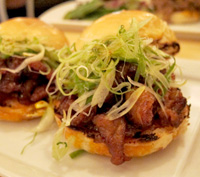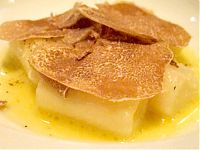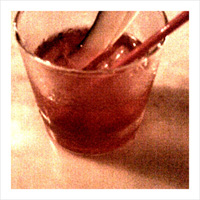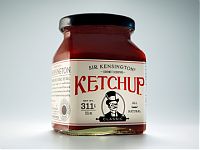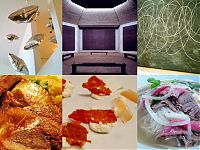Alto Adige
by Olivier Chow
December 1, 2006
Alto Adige or South Tyrol, depending on your cultural standpoint, is a less visited and often overlooked region of Italy, possibly because it is less Italian than, say, Sicily or Tuscany. Formerly part of Austria, this superb bilingual region — Italian and German — located on the border of Austria and Switzerland has much to offer visitors: castles, neo-classical villas and the beautiful Dolomites. It is also home to Oetzi, the oldest mummy, now in the South Tyrol Museum of Archaeology in Bolzano that devotes half of its space to the material culture of this unfortunate little man.
One of the main tourist destinations is the thermal resort of Merano, first popularised by trendy Austrian imperial sensation Sissi (still a popular name in the region). If you walk up and down the winter promenade you’ll understand why. Merano is still catering to jet-setters from all over Europe thanks to diet and anti-aging guru Henri Chenot’s well-being center at the hotel Palace Merano, which has recently welcomed Pavarotti, Princess Caroline of Monaco and Zidane, the recently retired French soccer star. Concomitantly, the newly designed Merano Thermal Baths attracts the beautiful people living in Northern Italy and beyond.
The region also boasts fantastic architecture, food, beer and wine, all of which reflect Italian and Austrian influences — a winning mix if you ask me. In December, don’t miss the beautiful Christmas markets of Alto Adige, very popular with the Milanese who dress up like Eskimos when they venture to Tyrol. Art from Tyrol is also of interest, especially if you like “tribal baroque,” a sort of weird genre where horns of mountain goats feature prominently (think Marie Antoinette meets Alpine mountain folks).
Rohrer
Eschio/Aschl 5
Verano
0473.278198
Closed during winter
Located on the beautiful mountain road between Merano and Bolzano, this unusual establishment is a traditional Tyrolean farm managed by Frau Rohrer that caters mainly to the local vacationers. It is best reached by car although there are buses going to Verano from Merano. The farm is located on a meadow complete with cows and forest — clearly evoking images of Heidi. One can also take beautiful walks from the farm. In the summer and on sunny days, the terrace is the place to enjoy the amazing vistas, beer, coffee or one of Rohrer’s specialty pies and cakes. The beautiful old stube or dining room is preserved from the 19th century as is evident when looking at the patina of the wood. This Tyrolean stube manages to conjure an archaic Alpine universe bordering on the tribal, a world that is slowly vanishing. Not surprisingly, the food is simple and as is often the case in the region, solid. Traditional Tyrolean dishes such as sauerkraut, wurst (sausage), knödel (dumplings), goulash, barley soups, and roast beef with vegetables dominate the menu. The service is very slow on busy days and weekends should be avoided.
Bräustuberl Forst
Via Venosta 9-10
Algund/Lagundo
0473.260270/260271
Located in Algund, or Lagundo if you have an Italian guidebook, — a suburb of Merano on the road to Switzerland — this extraordinary fantasy of a brewery (think medieval version of Willy Wonka’s chocolate factory) is a must for any traveller visting the region. This sort of neo-Gothic brewery/castle with wooden bridges defies architectural classification and is in itself worth the visit. The actual brewery is something out of an old James Bond movie and could have been the set of one the “evil” laboratories with its outdated 1960s scientific design. In the summer, it boasts a real beer garden — not one of those wannabe beer gardens that have become popular. The restaurant has been serving great ale and traditional fare at unbeatable prices since 1857. Its ambiance is popular, loud and medieval with wooden tables and benches. It’s both a local and Italian tourist hang-out — so be ready for the wait as they don’t take reservations. The service is sloppy to say the least, yet surprisingly quick.
There are six types of locally-produced beers of which I recommend the full, unfiltered and naturally bitter hausbier which is a real rough traditional Alpine beer. The food is simple but good, however, be warned: this is not spa food. This birreria does not do “light”, especially in winter but what it does — Alpine gastronomy — it does well. I strongly advise the gerstsuppe — a delicious and very nourishing barley soup specific to the region with smoked Tyrolean bacon (called speck), celery, carrots and potatoes. Another seasonal specialty, the hirshragout or venison stew was very tasty and filling, accompanied with spätzle, typical Alpine mini-dumplings made of flour and eggs, and blaukraut, a regional cabbage cooked with apples seasoned with cinnamon. Another specialty, the hausmeisterteller or the chef’s dish consisted of a very generous composition of sausages such as the meraner wurst (a larger version of the frankfurter), smoked pork chop and pork shin with sauerkraut and knödel, a massive dumpling made of bread and speck.
Carleto
Secret location, somewhere around Merano
For initiates only (you will need a local “contact” to get you in). This is one of the strangest places in the region but well worth it. This “restaurant” is actually a private club and one needs a code and password to get into the restaurant. From the moment you step inside, you cross into a bizarre retro-kitsch fetishistic fantasy that simply escapes traditional design concepts. The food is a set menu — between five and ten dishes — and there is a vegetarian option (actually better than the non-vegetarian one) which is creative, seasonal and fresh: first we had a barley salad with sweet peppers, followed by a delicious chestnut soup with potatoes (fantastic, except for the color), then imported South-American asparagus. After the asparagus, Carletto served us one of those giant raviolis with a sophisticated name that a non-Italian speaker simply would not remember: it had an egg inside (sunny-side up). Superb. It was the clou (high point) of the meal. This was followed by a delicious zucchini and mushroom soufflé with béchamel sauce and finally a chocolate mousse, which was merely adequate. The experience was altogether sensational because of the ambiance, outrageous interior (make sure you visit the toilets) and cloak-and-dagger entry process.
Olivier Chow is an art critic based in London and has spent many years working, living and eating abroad, from Paris to Afghanistan, Cambodia, Congo and Macedonia. He knows a few good places around the globe and has dined in some of the finest restaurants in Central Africa. During his free time, he enjoys cooking traditional peasant recipes from his native Switzerland.



